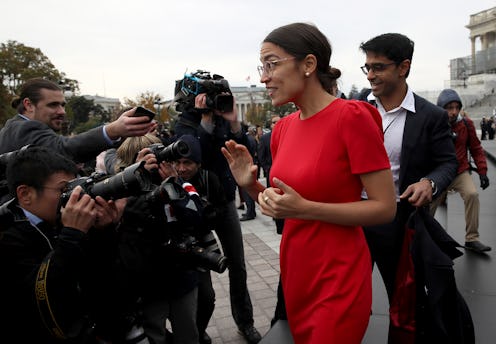News
Here's How Ocasio-Cortez's 70 Percent Top Tax Rate Would Actually Work

Republican and House Minority Whip Steve Scalise's Twitter fued with Rep. Alexandria Ocasio-Cortez got a lot of people talking about the freshman Democrat's proposal to fund the Green New Deal by imposing a new hefty tax rate on the country's richest taxpayers. On Saturday, Scalise argued that Ocasio-Cortez's plan amounted to Democrats taking away 70 percent of taxpayers' income and giving it to what he called "leftist fantasy programs." But just how does Ocasio-Cortez's 70 percent top tax rate actually work?
First, it seems important to clarify that contrary to what Scalise wrote in his tweet, Ocasio-Cortez hasn't proposed simply taking 70 percent of all taxpayers income. Rather her proposal calls for subjecting taxpayers who earn more than $10 million a year to a tax rate as high as 70 percent. According to The Washington Post, government data shows that only roughly 16,000 people reported earning more than $10 million in 2016. Compare that to the 140.9 million people who paid taxes that same year and it's fairly clear that those who earn $10 million or more a year make up a very, very small percentage — indeed, likely less than 0.05 percent — of all taxpayers.
"There's an element where, yeah, people are going to have to start paying their fair share in taxes," Ocasio-Cortez said when she first floated her proposal, in an interview with Anderson Cooper that aired Friday on CBS' 60 Minutes. She argued that in a progressive tax rate system you sometimes see marginal tax rates as high as 60 to 70 percent when you move into the highest tiers. "That doesn't mean all $10 million are taxed at an extremely high rate, but it means that as you climb up this ladder, you should be contributing more," she said.
Ocasio-Cortez's proposal isn't actually as radical as Republicans like Scalise have implied. As a number of media outlets have reported, the United States had a similarly, if not much higher, high top marginal tax rate in the mid 40s and 50s. Under former President Dwight Eisenhower, for example, the top tax rate sat just above 90 percent. It fell to 70 percent under former President John F. Kennedy and remained as high as 50 percent for much of former President Ronald Regan's presidency before dropping to 38 percent in 1986, according to Vox.
What's more, The New York Times' Paul Krugman pointed out that economist and Nobel laureate Peter Diamond has previously estimated the most optimal top tax rate to be 73 percent. In an analysis for The Washington Post, former U.S. Treasury Department official Mark Mazur estimated that Ocasio-Cortez's proposal could give the federal government an additional $72 billion a year, totaling roughly $720 billion after 10 years. Still, Mazur and other experts told The Post that many wealthy individuals would likely work the system to find ways to at least limit or reduce the taxes they'd ultimately owe.
However, it remains unclear if a 70 percent top tax rate like the one Ocasio-Cortez floated Friday could even fully fund the Green New Deal, a stimulus program that aims to address issues like economic inequality and climate change. Such an ambitious economic stimulus program, if ever approved, would likely require significant funding to get off the ground.